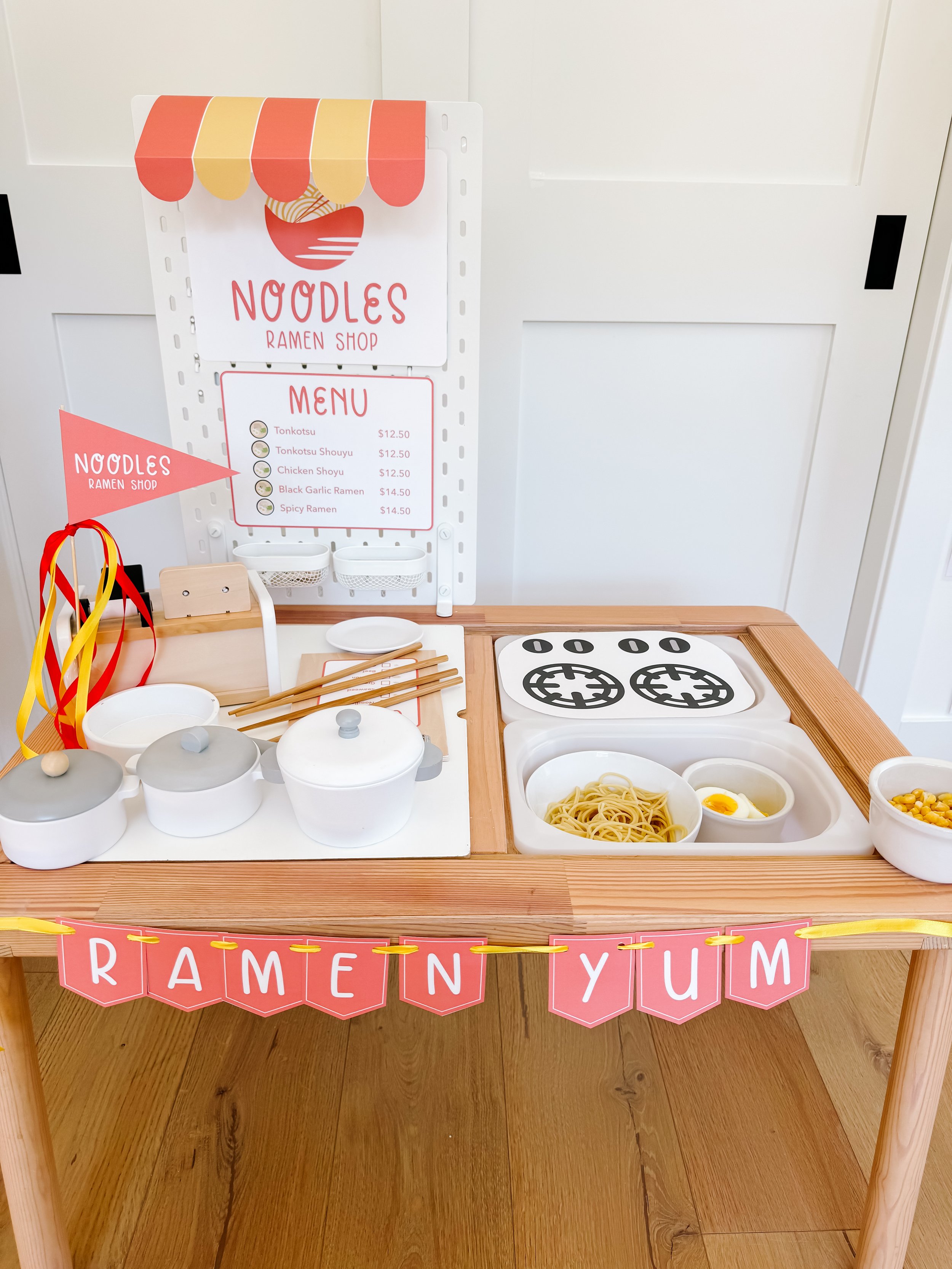Step into a world of imagination and hands-on learning with my Ramen Noodle Shop sensory and dramatic play setup! This ramen shop experience combines taste-safe sensory play with dramatic play elements, giving your little one the opportunity to explore textures, practice fine motor skills, and engage in pretend play. Let's take a look at the setup, step-by-step instructions for each sensory bin, and the learning benefits of this fun and interactive activity.
Ramen Shop Printable Decor
To bring the ramen shop to life, I’ve designed a set of printable decor, perfect for your play space. These printables are great for setting the scene and encouraging imaginative play.
Ramen Shop Flag & Banner: Hang the flag and banner to mark the entrance to your ramen shop, inviting little chefs and customers inside.
Shop Sign: The shop sign adds a personal touch, labeling your ramen stand as the best noodle shop in town!
Awning: Add the printable awning over your setup for an authentic ramen shop feel.
Menu: Display the ramen shop menu, listing the ingredients and ramen types your child can “prepare” in their noodle bowls.
Now, let's dive into the sensory play stations!
Sensory Bin 1: Make Your Own Bowl of Ramen
Materials:
Cooked spaghetti (as ramen noodles)
Hard-boiled eggs (cut in half)
Frozen corn (thawed)
Small bowls and utensils
Instructions:
Place the cooked spaghetti in the bin and separate the hard-boiled eggs and corn into smaller bowls.
Provide small bowls and utensils for your child to scoop noodles, eggs, and corn to create their ramen dish.
Encourage your child to add each ingredient to their bowl, exploring the different textures and practicing fine motor skills.
Learning Benefits:
Fine Motor Skills: Picking up noodles, scooping corn, and placing eggs require coordination and strength in small hand muscles.
Sensory Exploration: Children get to experience the texture of soft noodles, firm eggs, and cold corn, stimulating their sense of touch.
Imaginative Play: By pretending to make their own bowl of ramen, children engage in creative play, fostering cognitive development.
Sensory Bin 2: Cook the Ramen Soup on a Printable Stove
Materials:
Printable stove cover (available in the ramen shop printable kit)
Pots, pans, and ladles
Water or a clear liquid substitute for “soup”
Instructions:
Place the printable stove cover over one of the small Trofast bins to create a pretend stovetop.
Fill pots and pans with water or a clear liquid substitute, and provide ladles for stirring.
Encourage your child to “cook” the ramen noodles and prepare a delicious soup by stirring the ingredients in the pots and pans.
Learning Benefits:
Problem-Solving Skills: Children learn how to simulate cooking, developing early reasoning as they navigate the process of preparing a meal.
Role Play: Pretending to cook fosters language development as children mimic real-life scenarios they observe in their own kitchens.
Coordination & Balance: Stirring the soup and transferring ingredients from the pot to the bowl challenges balance and hand-eye coordination.
Sensory Bin 3: Be the Ramen Shop Owner
Materials:
Play cash register
Play money
Ramen bowls and utensils
Instructions:
Set up a small bin with a cash register and play money for your child to pretend to be the ramen shop owner.
Once a customer (you or another child) has created their bowl of ramen, they can take it to the register to pay for their meal.
Have your child practice counting out money and giving the correct change.
Learning Benefits:
Math Skills: Handling play money introduces basic math concepts like counting, addition, and subtraction.
Social Skills: Role-playing as the shop owner helps children practice communication, turn-taking, and customer service.
Imaginative Play: Running a ramen shop encourages creative thinking and helps children understand real-world roles and responsibilities.
Learning Through Taste-Safe Sensory Play
This ramen shop sensory play setup is a great way to introduce young children to new textures, role-playing, and early math skills in a fun and safe environment. Using taste-safe ingredients ensures that even if your little one decides to explore with their mouths, you can feel confident in the safety of the materials.
Vocabulary Words for Ramen Noodle Shop Play
Enhance your child’s language development by incorporating these vocabulary words into your ramen noodle shop play:
1. Noodle
2. Ramen
3. Soup
4. Bowl
5. Spoon
6. Ladle
7. Corn
8. Egg
9. Shop
10. Cash register
11. Money
12. Menu
13. Order
14. Customer
15. Owner
16. Stove
17. Pot
18. Pan
19. Boil
20. Steam
21. Chopsticks
22. Ingredients
23. Broth
24. Chef
25. Receipt
With these engaging sensory bins and dramatic play elements, your child will have a blast pretending to run their own ramen noodle shop while practicing essential skills. From sensory exploration to role-playing and math, this setup encourages children to learn through play in a safe and stimulating environment. Don't forget to download the printable decor to complete your ramen shop experience!
By incorporating taste-safe sensory play, you provide toddlers with a hands-on learning experience that fosters curiosity, creativity, and cognitive growth. Happy ramen-making!















